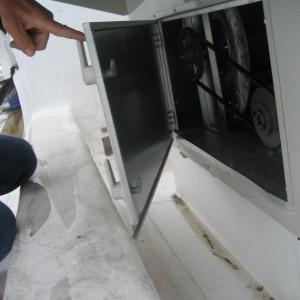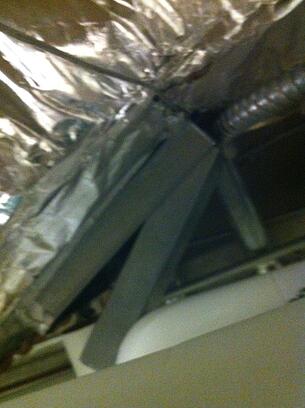Throughout the commissioning process, we often find issues with accessibility to equipment, whether it be a heat pump above a ceiling grid or an air handler in a mechanical room. Accessibility to all aspects of a unit is frequently overlooked during the design and construction process. Having adequate clearance is important for the building owner and the maintenance faculty.
Due to the tight spacing typically allowed for HVAC equipment and the associated ductwork and piping, accessibility is not likely to be perfect. Although it’s not ideal to have to work around piping, it may be the only option. However, all access doors and isolation valves for the unit should be useable, without jeopardizing the safety of the person standing close to the top of an 8-foot ladder. We are, however, able to review accessibility during different steps of the commissioning process to help ensure that the equipment will be fully serviceable when it is handed over to the owner.
Design Review
During design review, the overall coordination amongst the different trades is reviewed (i.e. lighting, HVAC equipment, domestic hot water equipment and all associated piping and ductwork). When the different systems are coordinated, there can typically be issues with accessibility. For example, a VAV box could be installed above a light fixture, making it difficult to access. We look for these kinds of issues during design review and suggest solutions to avoid having the project constructed this way. Catching these issues in design is by far the most cost effective means of addressing them.
Construction Checkout
The construction checkout process is accomplished using verification checklists to ensure that the equipment and components are properly installed. When we perform construction checkout on HVAC equipment, one of the line items we always look at is whether the piece of equipment can be safely accessed for maintenance. This applies to all components of the unit, such as isolation valves, balancing valves, test ports, drains, etc. In situations where there are units above a ceiling that is not a grid with removable tile, we make sure there are access doors in a proper location that will allow all parts of the unit to be reached. To ensure there are no issues, we will manipulate the different scenarios that can come up when accessing a unit, such as opening all access doors, replacing filters, turning valves, etc. For certain equipment, we will review if the installed clearances are acceptable per the manufacturer’s documentation and can make recommendations to the building owner if we foresee any issues with an installed unit. It is better to realize accessibility issues early in the construction process before walls and ceilings are completed so that the appropriate action is still feasible.
Examples of Accessibility Issues Found in the Field
 Figure 5: Access door for an RTU blocked and can’t be fully opened, making service to the belt difficult.
Figure 5: Access door for an RTU blocked and can’t be fully opened, making service to the belt difficult.Equipment accessibility is important for the safety and general wellbeing of the building. All building equipment should be easy to access and use. This improves the overall longevity and performance of the building and will make it easier for maintenance and upkeep of HVAC equipment in the future. The best thing a designer can do is ask the maintenance staff what they want rather than rely on the manufacturer’s cut sheet or what a contractor might recommend. Nearly every project has maintenance staff waiting in the wings to take over the building and if they are engaged early, often their experience and insight will provide valuable input into what is necessary for truly effective access to equipment and components.









